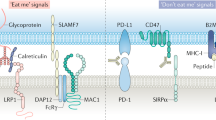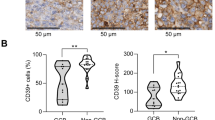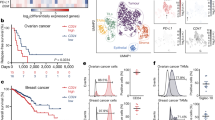Abstract
SGN-40 is a therapeutic antibody targeting CD40, which induces potent anti-lymphoma activities via direct apoptotic signalling cells and by cell-mediated cytotoxicity. Here we show antibody-dependent cellular phagocytosis (ADCP) by macrophages to contribute significantly to the therapeutic activities and that the antitumour effects of SGN-40 depend on Fc interactions.
Similar content being viewed by others
Main
CD40 is a member of the tumour necrosis factor (TNF) receptor superfamily and is expressed predominantly on haematopoietic cells, including B-cells, dendritic cells, monocytes, macrophages, activated B-cells and CD8+ T-cells (reviewed in van Kooten and Banchereau (2000)). In lymphoid malignancies, CD40 is present on B-cell precursor acute lymphoblastic leukaemia (ALL (Uckun et al, 1990)), non-Hodgkin's lymphoma (NHL (Uckun et al, 1990)), Hodgkin's lymphoma (HL (O'Grady et al, 1994)) and multiple myeloma (MM (Westendorf et al, 1994)).
The humanised monoclonal antibody targeting CD40 (SGN-40) induces potent antitumour effects when tested on CD40-positive tumour cell lines representing a variety of haematologic malignancies (Tai et al, 2004; Law et al, 2005). The mechanisms mediating the antitumour activity of SGN-40 include direct cytotoxic signalling, inducing caspase-3 activation and apoptosis of tumour cells (Law et al, 2005; Tai et al, 2005) and natural killer (NK) cell-mediated ADCC. Both, direct cell killing and NK cell-mediated ADCC are enhanced by antibody crosslinking (Law et al, 2005) when tested in vitro. However, the mechanism involved in mediating anti-lymphoma activity of SGN-40 in vivo remained to be investigated.
The ability of several human IgG1-type therapeutic antibodies to engage human effector cells varies significantly, depending on the target antigen and tumour type, and variable degrees of tumour cell death induced by NK cells, neutrophils and macrophages were reported for anti-CD19, -20 and -70 antibodies (reviewed in Tedder et al (2006)). Here we show for the first time that macrophages contribute significantly to the antitumour effects of SGN-40 when tested in models of human lymphoma. In addition, a mutant form of SGN-40, lacking Fc-receptor interactions (SGN40-IgG1v1), lacked therapeutic activity when tested in vitro and in mice implanted with B-cell lymphomas. The important role of macrophages in mediating therapeutic activity described here may help to guide the clinical development of SGN-40 for the treatment of B-cell malignancies.
Materials and methods
Cells and reagents
The CD40-positive lymphoma cell lines Ramos (NHL, Burkitt's lymphoma) and WIL2-S (B-cell lymphoma) were obtained from the American Type Culture Collection (ATCC, Manassas, VA, USA). The CD40-negative cell line L540cy was kindly provided by Dr Phil Thorpe (University of Texas, Southwestern Medical School, Dallas, TX, USA). Cells were grown in RPMI (Life Technologies Inc., Gaithersburg, MD, USA) supplemented with 20% fetal bovine serum (FBS).
Construction and expression of SGN-40G1v1 variant antibody and Fcγ receptors
The anti-CD40 variant containing the mutations, E233P:L234V:L235A (Armour et al, 1999) (SGN-40G1v1) was generated using the Quikchange Site-Directed Mutagenesis system (Stratagene, La Jolla, CA, USA). The SGN-40 variant heavy chain and SGN-40 light chain were each cloned into the expression vector pDEF38 (Running Deer and Allison, 2004) downstream of the CHEF EF-1α promoter and stably expressed in CHO-DG44 (Urlaub et al, 1986) cells. SGN-40 and SGN-40G1v1 proteins were expressed in CHO-DG44 cell lines and purified by protein A chromatography. Complementary DNA clones for human (hu) FcγRI (IMAGE clone 5248549), huFcγRIIIA V158 (IMAGE clone 5206097) and huFcɛR γ chain (IMAGE clone 5219148) were obtained from Invitrogen (Carlsbad, CA, USA) and coding regions were introduced into a mammalian expression vector system. Proteins were expressed in CHO-DG44 cell lines and highly expressing clones were selected by FACS and recovered by limited dilution cloning. Preliminary pharmacokinetic analysis of serum samples from treated mice revealed comparable characteristics between SGN-40 and SGN-40G1v1 (data not shown).
In vitro characterisation of antibody binding
SGN-40 was labelled with Alexa Fluor 488 carboxylic acid–succinimidyl ester conjugation using the Invitrogen Alexa Fluor 488 labeling kit (Invitrogen). For binding experiments, Ramos or stable CHO DG-44 cells expressing huFcγRI and huFcγRIIIA V158 were mixed and combined with serial dilutions of SGN-40 or the SGN-40G1v1 variant. Labelled cells were detected using an LSRII FACS analyzer (Beckton Dickinson Biosciences, San Jose, CA, USA). The flow cytometry data was analysed with a one site competition model equation using Prism v4.01 (GraphPad Software, San Diego, CA, USA).
Antibody-dependent cellular phagocytosis assay
The assay was performed as described earlier (McEarchern et al, 2007). Briefly, after labelling of CD40-positive target cells (Ramos), cells were pre-coated with SGN-40 or SGN-40G1v1 and incubated with monocyte-derived macrophages. The purity of the macrophage preparations were routinely >95% (data not shown).
Xenograft models and effector cell ablation and IHC analysis
Tumour bearing CB-17/lcr SCID mice were depleted of effector cells by using anti-asialo-GM 1 (1.25 mg kg−1, neutrophils) and anti-Gr-1 (4 mg kg−1, NK cells) clodronate encapsuled liposomes (CEL, macrophage), as described earlier (Oflazoglu et al, 2007). For IHC analysis, liver and spleen sections were stained with an anti-mouse F4/80 (macrophage marker) (AbD Serotec, Oxford, UK) using the Bondmax autostainer (Leica Microsystems Inc., Bannockburn, IL, USA) with an alkaline phosphatase-fast red detection kit. Mice were monitored at least twice per week and were sacrificed when they exhibited signs of disease, including weight loss of 15–20%, hunched posture, lethargy, cranial swelling or dehydration. Statistical analysis was conducted using the log-rank test with the Graphpad Prism Software Package version 4.01 (Graphpad). All animal experiments were performed according to the guidelines of the Institutional Animal Care and Use Committee (IACUC).
Results and discussion
To study the contributions of Fc-receptor interactions to the antitumour activity of SGN-40, we constructed an Fc variant form of SGN-40 containing a substitution of three amino acids in the Fc portion of the γ1 heavy chain (SGN-40G1v1). When introduced to other therapeutic MAbs of the IgG1 isotype, these changes resulted in abolished Fc-receptor interactions (Armour et al, 1999). As expected, no changes in the ability of SGN-40 and SGN-40G1v1 to bind to CD40 were observed (Figure 1A). However, competition binding assays with cells expressing human or mouse CD16 (FcγRIII) and CD64 (FcγRI) confirmed that SGN-40G1v1 lacked binding affinity to Fc receptors (Figure 1B). For SGN-40, weaker binding to mouse relative to human CD64 (FcγR1) and lack of binding to mouse CD16 (FcγRIII) were also noticed. Although Fcγ-receptor interactions are essential for effector cell activation, no direct correlation between binding affinities of therapeutic antibodies and activation of effector cells were reported (Richards et al, 2008), because these responses are ultimately regulated by the balance between activating and inhibitory signals delivered through Fcγ receptors. Therefore, the differences in binding affinity of SGN-40 between Fcγ-RI+III are not predictive for antitumour activities in vivo.
SGN-40 mediates antibody-dependent cellular phagocytosis (ADCP) activity and requires functional Fc–FcγR interaction in vitro. (A) Binding of SGN-40 and SGN-40G1v1 to CD40+ Ramos cells was detected by flow cytometry. EC50 values are 0.510 and 0.528 nM for SGN-40 and SGN-40G1v1, respectively. (B) Binding of SGN-40 and SGN-40G1v1 to CHO DG-44 cell lines expressing human or mouse FcγRI (CD64) and FcγRIIIA V158 (CD16) as determined by flow cytometry. Data is reported as the percent of maximum fluorescence, calculated by the sample fluorescence divided by the fluorescence of cells stained with anti-CD40-Alexa Fluor 488. NMB=non-measurable binding. (C) SGN-40 induces ADCP activity in vitro as determined by flow cytometry and fluorescence microscopy. Ramos target cells were labelled with PKH26 lipophilic dye for tracking purposes, and treated with non-binding control IgG or SGN-40 MAb and mixed with human monocyte-derived macrophages (Mø). Mø were stained with PE-conjugated anti-CD11b. Cells present in the upper right quadrant (PKH26+CD11b+) are Mø that internalised tumour cells. For fluorescence microscopy, tumour cells were labelled with PKH67 (green) and the macrophages were detected with Alexa Fluor 568-conjugated antibody specific for CD11b (red). No ADCP activity was detected on control, CD40-negative Hodgkin's lymphoma (HL) cells L540cy (D) CD40-positive Ramos, WIL2-S and the CD40-negative L540cy target cells were labelled with PKH26 lipophilic dye, treated with varying concentrations of SGN-40, SGN-40G1v1 or non-binding control IgG then mixed with Mø. (E) Survival curve of mice implanted with Ramos tumour cells and left untreated or following treatment with 4 mg kg−1 SGN-40 or SGN-40G1v1 on day 1 (n=10 per group), untreated vs SGN-40 (P<0.0001), untreated vs SGN-40G1v1 (P=0.7190), SGN-40 vs SGN-40G1v1 (P<0.0001). Data shown are from one representative of a total of two independent experiments.
To determine the levels of antibody-dependent cellular phagocytosis (ADCP) engagement, SGN-40 and SGN-40G1v1 were incubated in presence of primary human monocytic cells and tested for their ability to induce phagocytosis of CD40+ Ramos (Burkitt's lymphoma, Figures 1C and D) and WIL2-S cells (B-cell lymphoma, Figure 1D) by macrophages. Although SGN-40 induced robust ADCP, SGN-40G1v1 was devoid of detectable ADCP activity, showing that Fc–Fcγ-receptor interactions are necessary for phagocytic uptake of target lymphoma cells (Figure 1D). These studies show that Fc-dependent ADCP may represent an important mechanism by which SGN-40 induces anti-lymphoma effects.
To investigate the relevance of Fc–FcγR interactions for overall therapeutic activity, we compared survival of tumour bearing mice treated with either SGN-40 or SGN-40G1v1. In contrast to SGN-40, SGN-40G1v1 did not delay disease progression relative to untreated mice (Figure 1E). These findings indicate that all mechanisms contributing to anti-lymphoma activities by SGN-40 are dependent on Fc interactions in this NHL model, including direct apoptotic signalling in tumour cells. Next, we were interested to identify the identity of the effector cells mediating the antitumour activity of SGN-40 in vivo. For this purpose, tumour-bearing mice were selectively depleted of either NK cells (Figure 2A), neutrophils (Figure 2B), macrophages (Figure 2C) or all three cell types combined (Figure 2D). Although the lack of NK cells and neutrophils did not significantly affect the antitumour activity of SGN-40, depletion of macrophages, either alone or combined with NK and neutrophil cells, resulted in decreased survival of tumour-bearing mice compared with non-effector cell ablated animals (Figures 2C and D, P=0.0016 and 0.0004, respectively). These findings are in agreement with an earlier report showing potent antitumour activity of SGN-40 in SCID-beige mice, which display impaired NK cell functions (Law et al, 2005). Antitumour activity was evident in macrophage ablated mice (Figure 2C), suggesting that non-macrophage-dependent mechanisms may contribute to the in vivo activity in this model, including direct apoptotic signalling in tumour cells. The degree of effector cell depletion was monitored by FACS or IHC analysis (Figure 2E). Robust target effector cell depletion was confirmed by flow cytometric analysis of splenocytes (NK cells, anti-DX5), peripheral blood (neutrophils, anti-CD11b) or by F4/80-IHC staining (macrophages) in liver sections.
Macrophages mediate antitumour activity of SGN-40 and requirement for intact Fc–FcγR interactions in vivo. (A) Mice implanted with Ramos tumours (NHL) were depleted of natural killer cells (−NK) (B) neutrophils (−Neut), (C) macrophages (−Mac) or (D) all subsets combined (−All). Mice were either left untreated or treated with 4 mg kg−1 SGN-40 on day 1 post tumour implantation (n=10 per group), using intraperitoneal injections. Untreated vs SGN-40 (P<0.0001), untreated vs −NK+SGN-40 (P<0.0001), SGN-40 vs −NK+SGN-40 (P=0.4611). Untreated vs −Neut+SGN-40 (P=0.0001), SGN-40 vs −Neut+SGN-40 (P=0.5969). Untreated vs −Mac+SGN-40 (P=0.002), SGN-40 vs −Mac+SGN-40 (P=0.0016). Untreated vs All depleted (P=0.0594), SGN-40 vs All depleted +SGN-40 (P=0.0004). Data shown are from one representative of a total of two or three independent experiments. (E) FACS analysis of spleen from NK cell-depleted mice using anti-DX5 antibody, or peripheral blood from neutrophil-depleted mice, using an anti-CD11b antibody. The right panels display IHC analysis of liver tissues isolated from macrophage-depleted mice using an anti-mouse-F4/80 antibody.
In humans, macrophages express all three Fcγ receptors, whereas neutrophils and NK cells express predominantly FcγRII and FcγRIII (Koene et al, 1997). Sequence nucleotide polymorphisms within the FCGR2 and FCGR3 loci in humans alter their binding affinities to IgG1 Mabs, and ultimately impact on downstream effector cell engagement of therapeutic Mabs such as the anti-CD20 antibody Rituximab (Weng and Levy, 2003). In addition, the contributions of effector cells to antitumour effects of therapeutic MAbs were shown to vary between tumour types. For example, FcγR II+III single nucleotide polymorphisms (SNPs) correlated with therapeutic activity of rituximab in NHL, but not in CLL patients (Cartron et al, 2002; Weng and Levy, 2003; Farag et al, 2004). Combined, these findings suggest that the analysis of patient Fcγ-receptor polymorphisms and comparison with clinical response rates may provide important information regarding the mechanism of action employed by SGN-40 in different heme-malignancies, including NHL and MM. Importantly, the chemotherapy agents used for the treatment of NHL were shown to interfere differentially with macrophage functions (Marcus and Hagenbeek, 2007). Given the important role of macrophages in mediating the therapeutic activity of SGN-40 described in this report, it is tempting to speculate that combining SGN-40 with therapeutic agents that enhance macrophage activities, including Revlimid in MM indications, may be beneficial.
Change history
16 November 2011
This paper was modified 12 months after initial publication to switch to Creative Commons licence terms, as noted at publication
References
Armour KL, Clark MR, Hadley AG, Williamson LM (1999) Recombinant human IgG molecules lacking Fcgamma receptor I binding and monocyte triggering activities. Eur J Immunol 29: 2613–2624
Cartron G, Dacheux L, Salles G, Solal-Celigny P, Bardos P, Colombat P, Watier H (2002) Therapeutic activity of humanized anti-CD20 monoclonal antibody and polymorphism in IgG Fc receptor FcgammaRIIIa gene. Blood 99: 754–758
Farag SS, Flinn IW, Modali R, Lehman TA, Young D, Byrd JC (2004) Fc gamma RIIIa and Fc gamma RIIa polymorphisms do not predict response to rituximab in B-cell chronic lymphocytic leukemia. Blood 103: 1472–1474
Koene HR, Kleijer M, Algra J, Roos D, von dem Borne AE, de Haas M (1997) Fc gammaRIIIa-158V/F polymorphism influences the binding of IgG by natural killer cell Fc gammaRIIIa, independently of the Fc gammaRIIIa-48L/R/H phenotype. Blood 90: 1109–1114
Law CL, Gordon KA, Collier J, Klussman K, McEarchern JA, Cerveny CG, Mixan BJ, Lee WP, Lin Z, Valdez P, Wahl AF, Grewal IS (2005) Preclinical antilymphoma activity of a humanized anti-CD40 monoclonal antibody, SGN-40. Cancer Res 65: 8331–8338
Marcus R, Hagenbeek A (2007) The therapeutic use of rituximab in non-Hodgkin's lymphoma. Eur J Haematol Suppl 67: 5–14
McEarchern JA, Oflazoglu E, Francisco L, McDonagh CF, Gordon KA, Stone I, Klussman K, Turcott E, van Rooijen N, Carter P, Grewal IS, Wahl AF, Law CL (2007) Engineered anti-CD70 antibody with multiple effector functions exhibits in vitro and in vivo antitumor activities. Blood 109: 1185–1192
O'Grady JT, Stewart S, Lowrey J, Howie SE, Krajewski AS (1994) CD40 expression in Hodgkin's disease. Am J Pathol 144: 21–26
Oflazoglu E, Stone IJ, Gordon KA, Grewal IS, van Rooijen N, Law CL, Gerber HP (2007) Macrophages contribute to the antitumor activity of the anti-CD30 antibody SGN-30. Blood 110: 4370–4372
Richards JO, Karki S, Lazar GA, Chen H, Dang W, Desjarlais JR (2008) Optimization of antibody binding to FcgammaRIIa enhances macrophage phagocytosis of tumor cells. Mol Cancer Ther 7: 2517–2527
Running Deer J, Allison DS (2004) High-level expression of proteins in mammalian cells using transcription regulatory sequences from the Chinese hamster EF-1alpha gene. Biotechnol Prog 20: 880–889
Tai YT, Catley LP, Mitsiades CS, Burger R, Podar K, Shringpaure R, Hideshima T, Chauhan D, Hamasaki M, Ishitsuka K, Richardson P, Treon SP, Munshi NC, Anderson KC (2004) Mechanisms by which SGN-40, a humanized anti-CD40 antibody, induces cytotoxicity in human multiple myeloma cells: clinical implications. Cancer Res 64: 2846–2852
Tai YT, Li XF, Catley L, Coffey R, Breitkreutz I, Bae J, Song W, Podar K, Hideshima T, Chauhan D, Schlossman R, Richardson P, Treon SP, Grewal IS, Munshi NC, Anderson KC (2005) Immunomodulatory drug lenalidomide (CC-5013, IMiD3) augments anti-CD40 SGN-40-induced cytotoxicity in human multiple myeloma: clinical implications. Cancer Res 65: 11712–11720
Tedder TF, Baras A, Xiu Y (2006) Fcgamma receptor-dependent effector mechanisms regulate CD19 and CD20 antibody immunotherapies for B lymphocyte malignancies and autoimmunity. Springer Semin Immunopathol 28: 351–364
Uckun FM, Gajl-Peczalska K, Myers DE, Jaszcz W, Haissig S, Ledbetter JA (1990) Temporal association of CD40 antigen expression with discrete stages of human B-cell ontogeny and the efficacy of anti-CD40 immunotoxins against clonogenic B-lineage acute lymphoblastic leukemia as well as B-lineage non-Hodgkin's lymphoma cells. Blood 76: 2449–2456
Urlaub G, Mitchell PJ, Kas E, Chasin LA, Funanage VL, Myoda TT, Hamlin J (1986) Effect of gamma rays at the dihydrofolate reductase locus: deletions and inversions. Somat Cell Mol Genet 12: 555–566
van Kooten C, Banchereau J (2000) CD40-CD40 ligand. J Leukoc Biol 67: 2–17
Weng WK, Levy R (2003) Two immunoglobulin G fragment C receptor polymorphisms independently predict response to rituximab in patients with follicular lymphoma. J Clin Oncol 21: 3940–3947
Westendorf JJ, Ahmann GJ, Armitage RJ, Spriggs MK, Lust JA, Greipp PR, Katzmann JA, Jelinek DF (1994) CD40 expression in malignant plasma cells. Role in stimulation of autocrine IL-6 secretion by a human myeloma cell line. J Immunol 152: 117–128
Acknowledgements
We thank Kim Kissler and Weiping Zeng for their help with conducting the animal experiments, Drs Paul Carter and Django Sussman for help in antibody engineering. Drs Tim Lewis, Gerald Neslund for their expert advice in the design of the studies and Mark Sandbaken for critical reading of the manuscript.
Author information
Authors and Affiliations
Corresponding author
Rights and permissions
From twelve months after its original publication, this work is licensed under the Creative Commons Attribution-NonCommercial-Share Alike 3.0 Unported License. To view a copy of this license, visit http://creativecommons.org/licenses/by-nc-sa/3.0/
About this article
Cite this article
Oflazoglu, E., Stone, I., Brown, L. et al. Macrophages and Fc-receptor interactions contribute to the antitumour activities of the anti-CD40 antibody SGN-40. Br J Cancer 100, 113–117 (2009). https://doi.org/10.1038/sj.bjc.6604812
Received:
Revised:
Accepted:
Published:
Issue Date:
DOI: https://doi.org/10.1038/sj.bjc.6604812
Keywords
This article is cited by
-
Recent advances in the development of protein–protein interactions modulators: mechanisms and clinical trials
Signal Transduction and Targeted Therapy (2020)
-
Boosting therapeutic potency of antibodies by taming Fc domain functions
Experimental & Molecular Medicine (2019)
-
Antibody drug conjugates and bystander killing: is antigen-dependent internalisation required?
British Journal of Cancer (2017)
-
Macrophages inhibit human osteosarcoma cell growth after activation with the bacterial cell wall derivative liposomal muramyl tripeptide in combination with interferon-γ
Journal of Experimental & Clinical Cancer Research (2014)
-
CD30 as a Therapeutic Target for Lymphoma
BioDrugs (2014)





